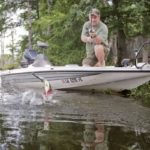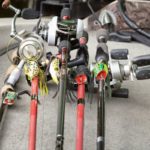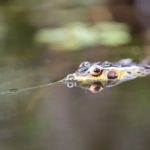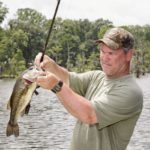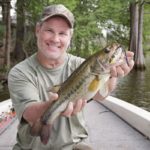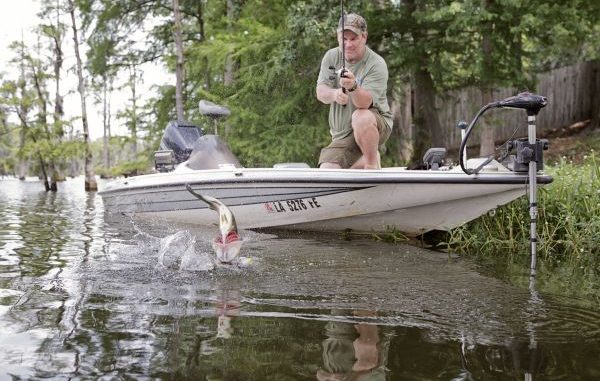
Flippin’ isn’t usually associated with any kind of topwater, but this bass angler breaks the rules by combining the technique with plastic frogs. And he catches fish most anglers would never reach.
Across the foggy water, Kenny Covington heard the conversation coming from a nearby boat.
“What’s he throwing?” one of the anglers asked.
Although he could scarcely make out the silhouette of the boat, Covington could tell they were close enough to know he was catching bass.
“Looks like he’s flipping something,” the other answered. “Maybe a jig — a worm?”
Covington couldn’t help but chuckle.
“If I would have idled over there and told them I was flipping a frog, they never would have even believed me,” he said.
Some flipping baits might look like frogs, and I can recall Texas rigging an old H&H frog for fishing lily pads in a local pond as I was growing up, but Covington was referring to neither.
“I was flipping a topwater frog,” Covington said.
Yeah, that makes a lot of sense. Flipping a topwater frog?
To prove his point, Covington invited me to meet him at a gnarly, twisted boat ramp beside the old Cypress Inn restaurant on Bayou DeSiard in Monroe.
And to make sure I left with no preconceived notions intact, he insisted we take nothing with us but topwater frogs.
Having no topwater frogs in my box, I ran by Toledo Tackle in Monroe the evening before and bought a pack of Ribbits, some Double Take Hooks, a Booyah Pad Crasher frog and a Booyah Poppin’ Pad Crasher frog.
As I stowed my rods in his boat the next morning, I noticed Covington had four rods with four different kinds of frogs tied on.
“The only thing weird about flipping frogs is the person who doesn’t do it,” Covington cracked.
A wry smile across his lips, Covington tossed me the keys to his truck.
“And if I were a betting man,” he continued, “I’d bet that by the time this trip is over, you’re not going to be so weird anymore.”
As we idled away from the contorted ramp, a closer inspection of Covington’s frogs revealed three cupped-faced frogs — a black one, a natural green one and a smaller green one, and one natural green-colored frog with a pointed nose.
“I’ve just had better luck with the popping-faced frogs,” Covington noted. “I throw black more than anything else because it silhouettes better in the shade pockets where bass hold, and I’ll throw the natural color if it’s really bright out.
“The small one — we don’t need to talk about it.”
I fully expected Covington to pilot what he called “the best boat I’ve ever owned because it’s paid for” to the closest grass bed and start casting his frogs to the outer edges or maybe in holes within the mat.
I really didn’t have it in my mind that he actually planned to flip his frogs.
A seawall is a far cry from a grass bed, but that’s where we first started flipping our frogs — Covington using his black Spro and I my Ribbit.
It wasn’t just a plain seawall, though. This one had a couple trashy-looking spots where vegetation and scum had collected around some limbs that had fallen from a nearby tree into the water.
“Now, with all these rubber frogs out nowadays, we’ve got adequate tools to take a topwater bait in places where we couldn’t fish one before and do it 10 months out of the year,” Covington said, as he deftly skipped his frog 20 feet underneath a dock jutting out from the seawall.
He started twitching his rod tip down and back, and his frog responded by zigzagging across the surface. It reminded me of a walk-the-dog retrieve.
“Looks like it’s just Zara Spook fishing,” I told Covington.
“It’s kind of like it, but it’s really not,” he responded. “The walking part is like a Zara Spook, but how are you going to fish a Zara Spook in a spot like this without having to constantly go in there to get it unhung?
“If you were throwing a Zara Spook, where would you be throwing it right now?”
The obvious answer was that I would have to fish the Spook around the open edges of the cover we were fishing. The same could be said about a Pop-R or any number of topwater baits with treble hooks hanging underneath.
“That’s right,” Covington went on. “And you’ll catch fish on the outside edges, but you’re only going to catch the aggressive fish.
“With this frog, I can take a Zara Spook or a Pop-R style presentation right in there to the less-aggressive fish.”
I saw exactly what Covington was doing but continued combing the same cover with my favorite watermelon-red-pearl Ribbit. I did notice that, although I could fish the same cover with my Ribbit that Covington was his Spro, my bait was in and out a lot quicker than his.
Neither one of us had caught any fish, though, so I didn’t see any need to cut off the Ribbit to tie on the Pad Crasher.
I cast my Ribbit toward a patch of vegetation squeezed between a cypress tree and a seawall, and steered it toward a tiny little hole in the grass.
Covington pitched his Spro right into the same spot after my bait cleared it. He bumped his rod a couple times and watched his frog walk back and forth in the middle of the coffee cup-sized hole.
It disappeared one twitch later.
“No doubt the Ribbit is a great frog,” he said while unhooking his bass. “I’ve caught a lot of fish on it and the Horny Toad, but this fish wasn’t aggressive enough to eat it.
“With this Spro frog, I was able to keep my bait in that spot longer and make it look alive at the same time.”
Covington had to catch two more bass to finally convince me to cut off my Ribbit and tie on my Pad Crasher.
I was disappointed right out of the gate because I just couldn’t get it to walk side to side.
My guide for the day said it had nothing to do with the lure, though.
“It’s your rod,” Covington said. “What is it, heavy action? Well, with that braided line you’re fishing, that heavy-action rod just became an extra heavy-action rod. You got something with a softer tip?”
It just so happened that I had a medium-action Abu Garcia Fantasista Regista with a Revo Beast spooled up with some 40-pound Spiderwire Fluoro-Braid.
I tied the frog on and noticed an immediate difference.
“I can work it better now,” I told Covington after a couple casts, “but it seems like I can’t get it started until a couple twitches, and it’s already out of the strike zone by then.”
Covington tossed me a pair of scissors and instructed me to cut about ¼-inch off each of the leg skirts.
“I’ve found that the long skirts these frogs have for the legs can work against the walking action,” he explained said. “The more you cut off the easier it is to walk, but you still want something hanging down back there for that natural look.
“Cutting off a quarter to a half inch seems to work best.”
The change was immediate, and I was able to start my Pad Crasher walking with the first twitch.
My patience was rewarded a few twitches later when a bass engulfed my frog.
As he noticed how my bass was hooked — with both hooks right through the top of its mouth — Covington told me that was one of the best things about flipping topwater frogs.
“They try to eat it just about every time they blow up on it,” he said. “Think about it this way: A bass that is eating out of hunger isn’t going to waste its time or energy striking and missing a bait.
“Most of the time, they’re either hooked exactly like that one, or they got it so far down their throats you can hardly see it.”
We continued working down Bayou DeSiard, skipping over the shallow banks and fishing the deeper banks. All the time, Covington was paying particular attention to what he called the “s— banks.”
“I look for places that make me say, man, look at that s—,” he said. “If it looks like s— you can bet nobody is going to take the time to fish it. Well, those are the exact kinds of spots you want to fish with a frog, because big fish gravitate to places that don’t get fished.”
Not too far down the bank, Covington spotted a corner where a boat dock jutted out from a seawall. The corner was full of matted vegetation surrounding several sticks and a floating Michelob Ultra beer can.
It was a spot I definitely would have passed up; however, Covington eased his boat through a maze of cypress trees and logs to get within flipping distance and skittered his frog right into the middle of the mess.
While unhooking a 3-pound bass, he told me how he thought this particular corner was a spot that hardly anybody would have even noticed much less took the time to maneuver in close enough to make two or three flips before having to maneuver back out.
Covington and I wound up flipping frogs on Bayou DeSiard for about four hours, and we found enough of those nasty spots to catch 15 bass.
As we loaded his boat, another angler asked us about our day.
“Pretty good morning,” Covington said. “We caught 15.”
“On what?” the fellow asked.
“Flipping frogs,” we both answered.
I don’t think he believed us.
